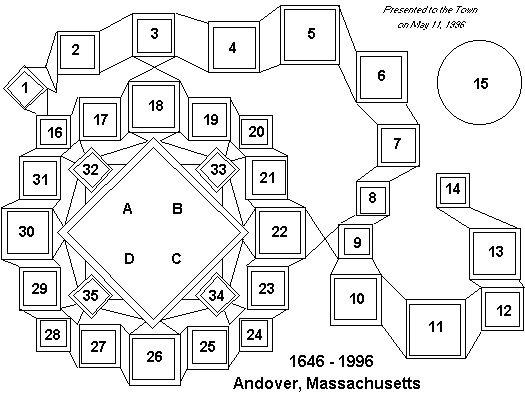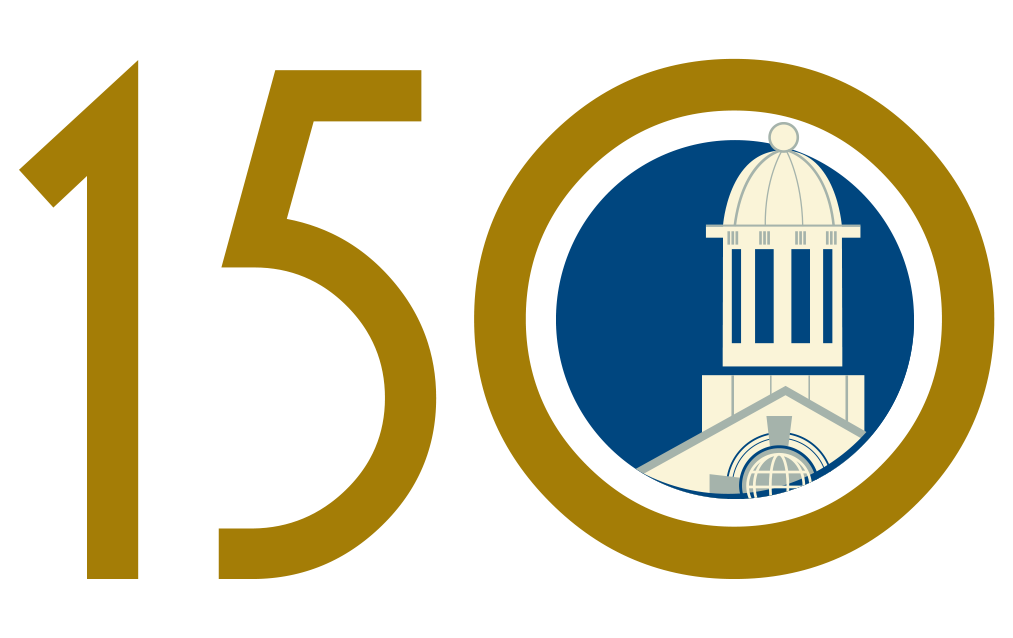Andover's 350th Celebration Quilt, "The Hill, the Mill, and the Till," takes its name from an old adage describing the Town. It was designed and made by a group of twenty local quilters, under the direction of Joan Ross. Over 1200 hours of talented labor have gone into its creation during the past year.
The focal point of the quilt is its unique center medallion, designed and appliqued by Judi Easley. She chose the Memorial Bell Tower (1922), the Ballardvale Mill (1835), and the Henderson Farm (1711) to symbolize the quilt's title, and adapted Toni Harris-Hadad's Anniversary logo to represent the Town's founding (1646). Coincidentally, these dates span the four centuries of Andover's existence.
Surrounding the center are 35 traditional pieced blocks, one for each decade since the Town was established. They were selected because their pattern names say something significant about the Town or its history. For example, "Tea Pot" symbolizes the original settlers' native town--Andover, Hampshire, England--and was contributed by the Sprat and Winkle Quilt Guild there. The three most prominent points in "Mariner's Compass" stand for the Town's original parishes: North (1646), South (1711), and West (1826). "Indian Trails" represents the Indian Ridge Reservation, a gift from a group of citizens during the Town's 250th Anniversary. For their own block, the quilters chose "A Stitch in Time." Its double meaning--honoring Andover's place in history with their handwork, and being done on time--had great appeal.
The unusual setting for the blocks was created by Joan Ross and her son Arnold, inspired by the designs in Blockbuster Quilts by Margaret J. Miller of Seattle, WA. In the background are hundreds of pieced triangles known as "flying geese." This very old pattern is echoed in the beautiful quilting that Gail Seeley designed and executed.
The label on the quilt's back contains its key--a scaled-down "map" showing the location of each block, its pattern name, and the name of its maker. Surrounding the label are small squares of 350 different contemporary fabrics. 235 of these fabrics also appear on the front of the quilt. The hand-painted "sky" cloth was commissioned from Adrienne Young in Portland, CT. Creative Quilting in North Andover and Cranberry Quilters in South Hamilton also supplied some of the fabrics, at generous discounts.
The Celebration Quilt Committee is delighted to present "The Hill, the Mill, and the Till" to the Town of Andover in honor of its 350th Anniversary, and hope that the Town's citizens enjoy viewing it as much as its quilters enjoyed creating it.
Presented to the Town on May 11, 1996

| 1 | Church Windows (Diane Murphy)--Andover's faith communities, led by South Church (1709). | 21 | Peace on Earth (Mary McCarthy)--the 350th quilters' prayer for the Town and the world. |
| 2 | Farmer's Fields (Pat Gall)--the importance of agriculture in the Town's past. | 22 | Crossroads (Joan Ross)--Andover's location, amidst federal, state, and local highways. |
| 3 | All Kinds (Tina Gatti)--our increasingly diverse ethnic and cultural composition. | 23 | Children's Delight (Jan Henderson)--saluting the children of Andover. |
| 4 | Friends & Neighbors (Connie Grew)--the cordial relationships among our townspeople. | 24 | Circuits (Fran Gikow)--the Town's "high-tech" industries. |
| 5 | Hard Times (Mary McCarthy)--the economic downturns in Andover's history. | 25 | Our Village Green (Joan Ross)--The Park at Chestnut and Bartlett. |
| 6 | Cog Wheels (Gail Seeley)--Andover's manufacturing firms, past and present. | 26 | Arrows of Peace (Joan Ross)--the Native Americans in Andover's history. |
| 7 | School House (Laura Robinson)--our schools, public, private, parochial, and home. | 27 | Yankee Ingenuity (Marta Totten)--a trait of our townspeople, regardless of ethnic heritage. |
| 8 | Town Meeting (Kay Foltz)--the Town's form of government since its founding. | 28 | Salem (Pat Gall)--Andover's part in the Salem witchcraft hysteria (1692). |
| 9 | Poppies (Karla Cook)--honoring all who have died in the Town's service, in war or in peace. | 29 | Independence Block (Jan Henderson)--the Town's role in the Revolutionary War. |
| 10 | Stitch in Time (Judi Easley)--the 350th quilters, weaving past, present, and future into our work. | 30 | Prosperity (Karla Cook)--the economic booms in Andover's history. |
| 11 | My Country (Joan Ross)--Samuel Smith's "My Country, 'tis of Thee" (1832). | 31 | Tea Pot (Sprat and Winkle Quilters)--our parent town: Andover, Hampshire, England. |
| 12 | Next Door Neighbors (Norma Gammon)--our bordering towns, especially So. Lawrence (1847). | 32 | Water Beauty (Joan Ross)--the Town's beautiful rivers, ponds, brooks, and streams. |
| 13 | Old Mill Wheel (Karla Cook)--the mills in Andover's history. | 33 | Pine Tree (Jennie Cline)--our lovely forests, reservations, and conservation lands. |
| 14 | Shop Windows (Tina Gatti)--the Town's retail businesses, another interpretation of "the Till." | 34 | Union (Annette Wright)--Andover's part in the Civil War. |
| 15 | Mariner's Compass (Joan Ross)--the three original parishes: North (1646), South (1711), and West (1826). | 35 | Hero's Welcome (Joan Ross)--honoring all who have served the Town, in war or in peace. |
| 16 | Hill & Valley (Carol DeStefano)--Andover's prominent topographical features. | A | Ballardvale Mill (Judi Easley)--on Andover Street (1836), symbolizing "the Mill." |
| 17 | Indian Trails (Gail Seeley)--Indian Ridge Reservation, given to the Town in 1896. | B | Henderson Farm (Judi Easley)--on River Road, (1711), symbolzing "the Till." |
| 18 | Fire Crackers & Rockets (Marianne Karp)-- the 4th of July Horribles Parade and fireworks. | C | Memorial Bell Tower (Judi Easley)--on Main Street (1922), symbolizing "the Hill." |
| 19 | Banker's Hours (Tina Gatti)--Andover's banks, past and present. | D | Anniversary Logo (Judi Easley)--symbolzing the Town's founding (1646). |
| 20 | Underground Railroad (Glenda Schaake)--the Town's aid to escaping slaves before the Civil War. |
Submitted for the 350th Celebration Journal
In March 1995, Norma Gammon inserted a small notice in the Townsman, asking for volunteers to make a quilt to commemorate Andover's upcoming 350th anniversary. Shortly thereafter, a dozen avid quilters gathered in the library, ready to begin this exciting project.
As we talked, it became clear that the group possessed boundless enthusiasm, and diverse but complementary skills. Ideas flew fast and furiously around the table. By the end of the evening, we had established one thing--while we all admired commemorative quilts with beautifully appliqued buildings and historical events, we wanted something different for Andover's celebration, more representative of quilting in the last decade of the 20th century.
Over the next few weeks, the basic theme for our quilt emerged. It would be contemporary with a bow to history--traditional pieced blocks surrounding an appliqued center, made with the latest fabrics, set in a non-traditional manner. The center would represent "the hill, the mill, and the till," as well as the 350th anniversary. The blocks, through their pattern names, would symbolize important aspects of Andover's past or present.
We researched town characteristics, events, people, and places, then searched through dozens of quilting books and magazines for candidate blocks. Our final list had well over 100 patterns, all with meaningful names for Andover. It was clear we couldn't use them all! We toyed with the idea of one for each year, but quickly came to our senses and settled for one per decade. In two hilarious marathon sessions, we struggled to reduce the list to 35, finally reaching a consensus on the best combinations of name and design. In the end, Fran Gikow and Joan Ross custom designed two of the blocks, when no acceptable patterns could be found.
During a whirlwind tour of local quilt shops and shows, we discovered just the right fabrics at Creative Quilting in North Andover, and Cranberry Quilters in South Hamilton. We also bought some gorgeous hand-painted material from Adrian Young in Portland, CT.
Everyone in the group contributed one or more blocks: Jennie Cline, Karla Cook, Carole DeStefano, Judi Easley, Kay Foltz, Pat Gall, Norma Gammon, Tina Gatti, Fran Gikow, Connie Grew, Jan Henderson, Marianne Karp, Mary McCarthy, Diane Murphy, Laura Robinson, Joan Ross, Gail Seely, Glenda Shaake, Marta Totten, and Annette Wright. In addition, quilters in Andover, Hamphsire, England, designed and pieced the block representing our founders' "home town."
Judi Easley designed and appliqued the quilt's unique center. She chose the bell tower at Phillips Academy (1922), the Ballardvale mill (1835), and the Henderson farm (1711), to symbolize "hill, mill, and till," and the 350th logo to represent the town's founding (1646). Coincidentally, these dates span the four centuries of Andover's existence.
Joan Ross and her son Arnold designed the quilt's unusual "wheel and path" setting, inspired by Margaret Miller's Blockbuster Quilts. Diane Murphy and Jan Henderson added the wonderful embroidery. Gail Seeley quilted it beautifully, using her own designs.
The quilt will be presented to the Town at the Anniversary banquet in May, 1996, after which it will be permanently hung in Memorial Library. In September, samples of each quilter's own work will also be on display there.

